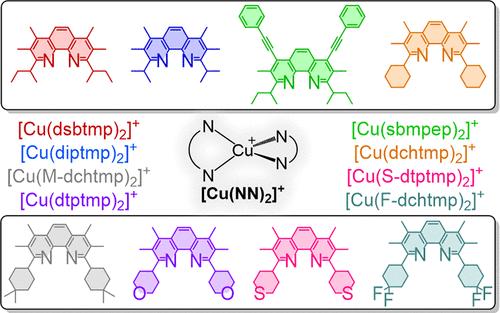当前位置:
X-MOL 学术
›
Acc. Chem. Res.
›
论文详情
Our official English website, www.x-mol.net, welcomes your
feedback! (Note: you will need to create a separate account there.)
Steric and Electronic Influence of Excited-State Decay in Cu(I) MLCT Chromophores
Accounts of Chemical Research ( IF 16.4 ) Pub Date : 2024-09-11 , DOI: 10.1021/acs.accounts.4c00476 Felix N Castellano 1 , Michael C Rosko 1
Accounts of Chemical Research ( IF 16.4 ) Pub Date : 2024-09-11 , DOI: 10.1021/acs.accounts.4c00476 Felix N Castellano 1 , Michael C Rosko 1
Affiliation

|
For the past 11 years, a dedicated effort in our research group focused on fundamentally advancing the photophysical properties of cuprous bis-phenanthroline-based metal-to-ligand charge transfer (MLCT) excited states. We rationalized that, by gaining control over the numerous factors limiting the more widespread use of CuI MLCT photosensitizers, they would be readily adopted in numerous light-activated applications given the earth-abundance of copper and the extensive library of 1,10-phenanthrolines developed over the last century. Significant progress has been achieved by recognizing valuable structure–property concepts developed by other researchers in tandem with detailed ultrafast and conventional time-scale investigations, in-silico-inspired molecular designs to predict spectroscopic properties, and applying novel synthetic methodologies. Ultimately, we achieved a plateau in exerting cooperative steric influence to control CuI MLCT excited state decay. This led to combining sterics with π-conjugation and/or inductive electronic effects to further exert control over molecular photophysical properties. The lessons gleaned from our studies of homoleptic complexes were recently extended to heteroleptic bis(phenanthrolines) featuring enhanced visible light absorption properties and long-lived room-temperature photoluminescence. This Account navigates the reader through our intellectual journey of decision-making, molecular and experimental design, and data interpretation in parallel with appropriate background information related to the quantitative characterization of molecular photophysics using CuI MLCT chromophores as prototypical examples.
中文翻译:

激发态衰变对 Cu(I) MLCT 发色团的空间位阻和电子影响
在过去的 11 年里,我们研究小组的专门工作重点是从根本上提高亚铜双菲咯啉基金属到配体电荷转移 (MLCT) 激发态的光物理特性。我们合理化地认为,通过控制限制 Cu MLCT 光敏剂更广泛使用的众多因素,鉴于地球上丰富的铜和上个世纪开发的广泛的 1,10-菲咯啉库,它们将很容易被许多光激活应用采用。通过认识到其他研究人员开发的有价值的结构-性质概念,以及详细的超快和常规时间尺度研究、预测光谱特性的计算机启发分子设计以及应用新颖的合成方法,已经取得了重大进展。最终,我们在施加协同空间影响以控制 Cu MLCT 激发态衰变方面实现了一个平台期。这导致将空间位阻与 π 共轭和/或感应电子效应相结合,以进一步控制分子光物理特性。我们从同源配合物研究中收集的经验教训最近扩展到异卵双(菲咯啉),具有增强的可见光吸收特性和长寿命的室温光致发光。本帐户引导读者完成我们的决策、分子和实验设计以及数据解释的知识之旅,同时提供与使用 Cu MLCT 发色团作为原型示例的分子光物理学定量表征相关的适当背景信息。
更新日期:2024-09-11
中文翻译:

激发态衰变对 Cu(I) MLCT 发色团的空间位阻和电子影响
在过去的 11 年里,我们研究小组的专门工作重点是从根本上提高亚铜双菲咯啉基金属到配体电荷转移 (MLCT) 激发态的光物理特性。我们合理化地认为,通过控制限制 Cu MLCT 光敏剂更广泛使用的众多因素,鉴于地球上丰富的铜和上个世纪开发的广泛的 1,10-菲咯啉库,它们将很容易被许多光激活应用采用。通过认识到其他研究人员开发的有价值的结构-性质概念,以及详细的超快和常规时间尺度研究、预测光谱特性的计算机启发分子设计以及应用新颖的合成方法,已经取得了重大进展。最终,我们在施加协同空间影响以控制 Cu MLCT 激发态衰变方面实现了一个平台期。这导致将空间位阻与 π 共轭和/或感应电子效应相结合,以进一步控制分子光物理特性。我们从同源配合物研究中收集的经验教训最近扩展到异卵双(菲咯啉),具有增强的可见光吸收特性和长寿命的室温光致发光。本帐户引导读者完成我们的决策、分子和实验设计以及数据解释的知识之旅,同时提供与使用 Cu MLCT 发色团作为原型示例的分子光物理学定量表征相关的适当背景信息。































 京公网安备 11010802027423号
京公网安备 11010802027423号